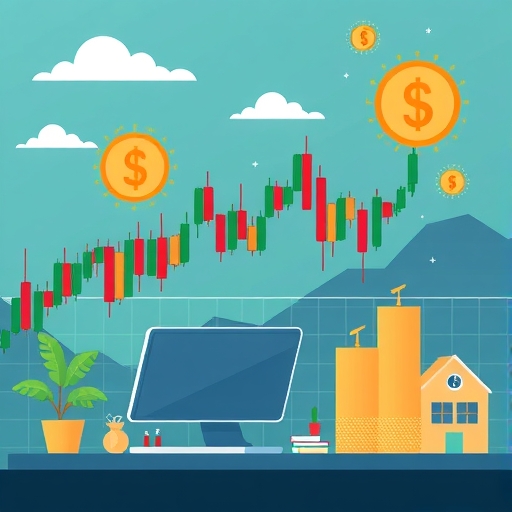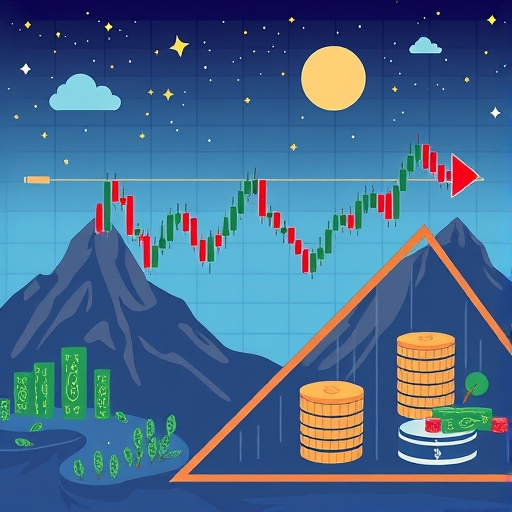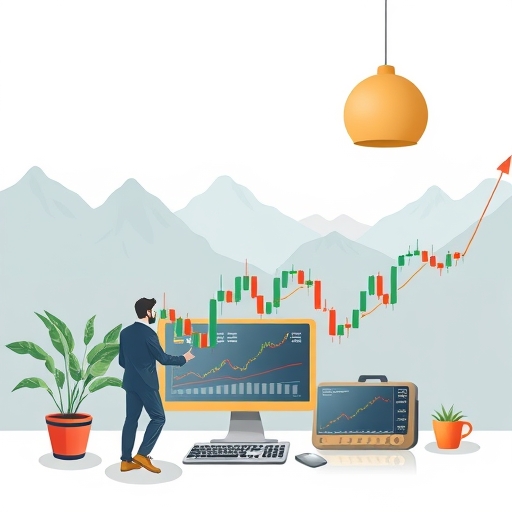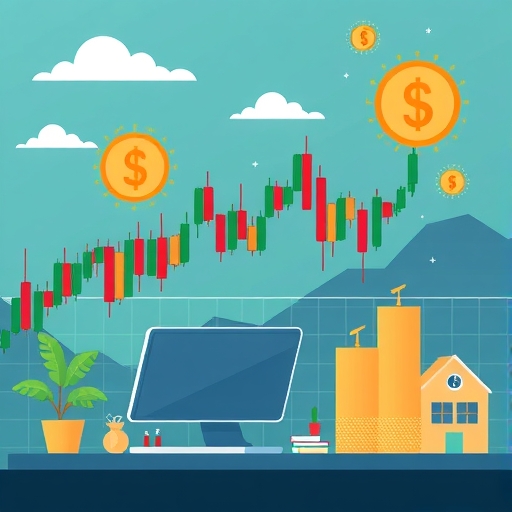Demystifying Leveraged Forex Trading: Unlocking Potential and Managing Risk
Have you ever wondered how traders can control vast sums of money in the global financial markets with a relatively small initial investment? The answer often lies in a powerful financial tool called leverage, especially prominent in Forex trading. While leverage can significantly amplify potential profits, it also comes with inherent risks that demand careful understanding and strategic management. In this comprehensive guide, we’ll explore what leverage and margin truly mean, uncover the benefits and potential pitfalls of leveraged trading, break down associated costs, and provide actionable risk management strategies. Our goal is to equip you with the knowledge to navigate the dynamic world of leveraged Forex trading responsibly and effectively.
The Fundamentals of Leverage and Margin in Forex
At its core, leverage is a financial tool that allows you to control a large position in the market with a relatively small amount of your own capital. Think of it as an interest-free loan provided by your broker. For example, if your broker offers 50:1 leverage, it means for every $1 of your capital, you can control $50 worth of a trading position. This mechanism is what makes markets like Forex accessible to individual retail traders who might not have millions of dollars to trade directly.

Understanding the concept of leverage is pivotal for anyone looking to engage in forex trading. It’s the engine that drives the potential for high returns, but also the factor that can accelerate losses if not handled with extreme caution. The specific leverage offered can vary significantly between brokers and regions, influenced by regulatory bodies aiming to protect retail investors from excessive risk. Always check the leverage limits applicable in your jurisdiction to ensure compliance and manage your exposure effectively.
The flip side of leverage is margin. Margin is the initial deposit or collateral required by your broker to open and maintain a leveraged trade. It’s not a cost, but rather a portion of your account balance that gets set aside or “blocked” to secure the potential losses of the trade. When you use higher leverage, your required margin decreases, freeing up more of your capital for other trades or simply keeping it liquid. Conversely, lower leverage means you need to put up more margin for the same trade size. Margin requirements are often influenced by market regulators and can vary significantly between brokers and different currency pairs or asset classes.
Here are some key takeaways regarding margin in Forex trading:
- Margin is collateral, not a transaction cost. It secures your leveraged position and is returned to you when the trade is closed.
- Higher leverage generally means a lower margin percentage required for the same trade size, allowing you to control larger positions with less capital.
- Brokers use margin to protect themselves from excessive client losses, ensuring there is sufficient collateral to cover potential negative equity.
- Understanding your available margin and maintaining a healthy margin level is crucial to avoid margin calls and potential automatic liquidation of your positions.
Let’s illustrate the power of leverage with an example. Imagine you want to trade the USD/CHF currency pair, and you believe the US Dollar will strengthen against the Swiss Franc. You decide to open a position worth $10,000. Here’s how it would look with and without leverage:
- Unleveraged Trading: If you trade without leverage, you would need to put up the full $10,000 of your own capital. If the market moves 1% in your favor, you make $100 profit (1% of $10,000). If it moves 1% against you, you lose $100.
- Leveraged Trading (e.g., 3% margin, equivalent to 33.3:1 leverage): With 33.3:1 leverage, you only need to put up 3% of the $10,000 position value as margin. This means your initial capital required is just $300 ($10,000 * 0.03). Now, if the market moves 1% in your favor, you still make $100 profit. But look at this: that $100 profit is now a whopping 33% return on your initial $300 capital ($100 / $300). This dramatically demonstrates how leverage can amplify your profits relative to the capital you commit. However, it’s crucial to remember that this amplification works both ways – losses are magnified just as much.
Unpacking the Benefits and Risks of Leveraged Trading
Leveraged Forex trading offers several compelling benefits that attract traders worldwide, but it’s equally important to understand the significant risks involved. Let’s delve into both sides of the coin.
Key Benefits of Leveraged Forex Trading:
- Amplified Profits: As we saw in our example, leverage allows you to control larger positions than your capital would normally permit. This means that even small price movements in your favor can result in substantial profits relative to your initial investment. This capital efficiency, sometimes called gearing, is a major draw for many traders.
- Accessibility to Large Markets: Without leverage, participating in the Forex market, which involves trading in large standardized units called “lots,” would require millions of dollars. Leverage makes these markets accessible to retail traders with limited capital, democratizing participation in global currency exchanges.
- Ability to Profit in Both Rising and Falling Markets: Unlike traditional stock investing where you primarily profit when prices go up, Forex trading allows you to take both “long” (buying) and “short” (selling) positions. If you believe a currency will strengthen, you go long; if you believe it will weaken, you go short. This flexibility means you can potentially profit regardless of the overall market direction.
- 24-Hour Trading Availability: The Forex market operates around the clock, five days a week, from Monday morning in Asia to Friday evening in New York. This continuous trading environment offers incredible flexibility, allowing you to react to news and events whenever they occur, day or night.

These benefits highlight why Forex trading, particularly with leverage, has gained immense popularity among a diverse range of investors and speculators. The ability to engage with global economic shifts and potentially generate significant returns from relatively small capital outlays presents a unique opportunity in the financial landscape. However, the appeal of high returns must always be balanced with a clear understanding of the concurrent risks, as leverage amplifies both positive and negative outcomes.
Key Risks of Leveraged Forex Trading:
While the benefits are attractive, the risks associated with leverage are equally potent and demand respect:
- Magnified Losses: This is the most critical risk. Just as leverage amplifies profits, it also magnifies losses. A small adverse price movement can quickly erode your initial margin and even your entire trading account if not managed properly.
- Margin Calls: What happens if your trade goes significantly against you? Your broker monitors your open positions and your account equity. If your losses cause your account’s available margin to fall below a certain threshold (the margin requirement), your broker will issue a margin call. This is a notification asking you to deposit more funds to meet the margin requirements, or to close some of your positions to reduce your margin usage.
- Automatic Liquidation: If you fail to meet a margin call, or if market movements are so rapid that your account equity falls to or below 100% of the required margin, your broker’s system will automatically close your open positions. This process is called liquidation (or stop-out), and it’s designed to prevent your losses from exceeding your account balance and putting you in debt to the broker. This can happen very quickly in volatile markets, often before you have a chance to react.
- Exchange and Interest Rate Fluctuations: Beyond price movements, sudden changes in global interest rates or significant economic news can impact currency values rapidly, leading to unexpected losses, affecting both your capital gains and any potential financing costs or credits.
- Psychological Traps: The allure of quick profits with leverage can lead to emotional decisions, such as over-leveraging, revenge trading after a loss, or taking on excessive risk. Controlling emotions and sticking to a disciplined trading plan are paramount.
Understanding these risks is paramount for any trader. One significant risk factor that often leads to automatic liquidation is the margin call. It’s a critical safety mechanism for brokers, but can be a devastating event for traders. Being aware of the conditions that trigger a margin call can help you avoid it and protect your trading capital.
| Common Margin Call Triggers | Description | Impact on Account |
|---|---|---|
| Significant Adverse Price Movement | The market moves sharply against your open position, causing substantial unrealized losses that reduce your account equity. | Reduces your account equity, bringing it closer to the margin requirement threshold and increasing the risk of a margin call. |
| High Leverage Usage | Opening positions with very high leverage, which inherently requires less free margin to absorb even small price fluctuations. | Leaves minimal buffer for market volatility, making your account highly susceptible to margin calls with minor market swings. |
| Insufficient Account Capital | Not having enough funds in your trading account relative to the size and number of your open positions. | Leads to a quick depletion of your available margin, potentially triggering a margin call even with moderate market movements. |
Navigating Costs and Calculating Margin Across Asset Classes
Beyond the simple act of buying and selling, leveraged trading, particularly in Forex, involves specific costs that you need to be aware of. Understanding these expenses is crucial for accurately assessing your potential profitability and managing your overall trading budget.
Costs Associated with Leveraged Trading:
- Spreads: The most common cost in Forex trading is the spread. This is the difference between the “bid” price (the price at which you can sell a currency pair) and the “ask” price (the price at which you can buy it). Brokers make money from this spread. For example, if EUR/USD has a bid price of 1.1000 and an ask price of 1.1001, the spread is 1 pip (0.0001). You effectively pay this spread when you open a trade, as you buy at the higher ask price and would immediately sell at the lower bid price.
- Commissions: While many Forex brokers advertise “commission-free” trading, this usually means their revenue comes solely from the spread. However, some brokers, especially those offering tighter spreads, might charge a direct commission per trade. This commission is typically a small fixed amount per lot or a percentage of the trade value.
- Overnight Financing (Rollover Rate): This is a key cost (or sometimes a credit) when you hold a leveraged position open past a certain time, typically 5 PM New York time (which marks the end of the Forex trading day). It’s essentially an interest payment. When you trade a currency pair, you are effectively borrowing one currency to buy another. The interest rate differential between the two currencies in the pair determines whether you pay or receive a small amount of interest. If you hold a currency with a higher interest rate and sell a currency with a lower interest rate, you might receive a credit. Conversely, if you hold the lower interest rate currency, you’ll pay a charge. This is also known as the rollover rate. These charges can accumulate, especially for positions held for several days or weeks.

Beyond the direct costs, the type of trading account you choose can also significantly impact your overall trading experience and cost structure. Different account types are designed to cater to various trader profiles and trading volumes, offering different fee structures and features.
| Forex Trading Account Types | Key Features | Best For |
|---|---|---|
| Standard Account | Typically offers larger lot sizes (e.g., 100,000 units), often with wider spreads, and generally no direct commission as the broker’s profit is built into the spread. | Experienced traders with larger capital who are comfortable trading in standard lot sizes and prefer a simpler commission structure. |
| Micro Account | Allows trading with much smaller lot sizes (e.g., 1,000 units), often with fixed or slightly wider spreads, and usually no commission. | Beginners or those with smaller capital who want to minimize risk per trade and trade with fractional lots. |
| ECN Account | Provides direct access to interbank liquidity, offering very tight raw spreads, but charges a transparent commission per trade. | Advanced traders seeking the lowest possible spreads, fastest execution, and direct market access, often preferred by scalpers and high-frequency traders. |
Leverage and Margin Across Different Asset Classes:
While the core concepts of leverage and margin remain consistent, their application and calculation can vary significantly depending on the asset class you’re trading. Regulatory bodies also play a crucial role in setting maximum leverage limits for retail traders, which can differ by region (e.g., 1:50 in the US, 1:20-1:50 in Europe for major currency pairs).
Here’s a general overview of how leverage and margin might look for different instruments:
| Asset Class | Typical Leverage Range (Retail) | Margin Calculation Basis | Key Considerations |
|---|---|---|---|
| Currency Pairs (Forex) | 1:10 to 1:500 (Regulator dependent) | Percentage of total trade value (e.g., 2% margin = 1:50 leverage) | Most common for high leverage. Varies by major/minor/exotic pairs. |
| Contracts for Difference (CFDs) | 1:5 to 1:500 (Varies by underlying asset) | Percentage of underlying asset value | Popular for indices (e.g., NASDAQ, FTSE), commodities, stocks, crypto. Leverage varies greatly by volatility. |
| Stocks (Equities) | 1:2 to 1:20 (Lower than Forex) | Fixed percentage of stock value (e.g., 50% for typical margin accounts) | Often through traditional margin accounts or stock CFDs. High volatility stocks may have higher margin. |
| Cryptocurrencies (e.g., BTC/USD) | 1:2 to 1:100 (Highly variable by broker/country) | Percentage of total crypto value | Very volatile, so higher leverage carries extreme risk. Regulatory environment still evolving. |
| Futures | 1:10 to 1:50 | Fixed dollar amount per contract (initial and maintenance margin) | Standardized contracts. Margin is typically a specific dollar amount rather than a percentage. |
| Metals (e.g., Gold, Silver) | 1:10 to 1:200 | Percentage of total commodity value | Often traded as CFDs. Margin can be higher for more volatile metals. |
The leverage ratio is a critical measurement, representing your total market exposure relative to your margin requirement. It’s often expressed as X:1 (e.g., 100:1). For example, a 1:100 leverage implies that for every $1 you put up as margin, you can control $100 of the position. This also means your margin requirement is 1% (1/100).
Strategic Risk Management in a Leveraged Environment
Given the amplified nature of leveraged trading, effective risk management is not just recommended; it’s absolutely essential for survival and long-term success. Without a solid risk management strategy, even a few losing trades can quickly decimate your trading account. We cannot stress this enough: always prioritize protecting your capital.
Essential Risk Management Strategies:
- Understand and Control Your Position Sizing: This is arguably the most crucial aspect. Never risk more than a small, predetermined percentage of your total trading capital on any single trade, commonly recommended to be no more than 1-2% for beginners, and rarely exceeding 5% for experienced traders. If you have a $1,000 account and risk 2% per trade, your maximum loss on any single trade is $20. This forces you to choose an appropriate position size based on your stop-loss level and account balance, rather than just the leverage offered.
- Always Use Stop-Loss Orders: A stop-loss order is an instruction to your broker to automatically close your trade if the price moves against you by a certain amount, thereby limiting your potential loss. It’s your primary defense against unexpected market movements and margin calls. Place your stop-loss order at a logical point where, if hit, your trading idea is invalidated, and the maximum loss is acceptable based on your position sizing rules.
- Avoid Over-Leveraging: While brokers may offer very high leverage (e.g., 1:500), it doesn’t mean you should use it all. High leverage tempts traders to open excessively large positions, making them highly vulnerable to small market fluctuations. Stick to a leverage ratio that aligns with your risk tolerance and trading strategy, often much lower than the maximum offered.
- Control Your Emotions: Fear and greed are powerful forces in trading. Don’t chase losses, don’t over-trade, and don’t deviate from your trading plan based on emotions. A disciplined approach, combined with a clear understanding of your risk limits, is key.
- Utilize a Demo Account for Practice: Before risking real money, we strongly recommend opening a demo account. This allows you to practice trading with virtual funds in real market conditions, test strategies, and become comfortable with your broker’s platform without any financial risk. It’s an invaluable learning tool for understanding how leverage and margin work in practice.
- Stay Informed: Keep an eye on the economic calendar and major news events that could impact the currency pairs you’re trading. Unexpected news can cause significant volatility and rapid price swings.
- Set Realistic Expectations: Understand that Forex trading is not a get-rich-quick scheme. It requires continuous learning, patience, and discipline. Focus on consistent, small gains and protecting your capital, rather than trying to hit a home run on every trade.
In addition to these strategies, traders can benefit from various tools and practices that aid in disciplined execution and informed decision-making. These tools are often integrated into trading platforms and are essential for implementing a robust risk management framework to safeguard your capital and enhance your trading performance.
| Essential Trading Tools | Purpose | Benefit to Risk Management |
|---|---|---|
| Stop-Loss Order | Automatically closes a trade when the price moves against your position by a specified amount, limiting potential losses. | Caps potential financial downside on a single trade, preventing significant account blow-ups due to adverse market movements. |
| Take-Profit Order | Automatically closes a trade when the price reaches a predetermined profit target, securing gains. | Helps secure profits at optimal levels and removes emotional decision-making when the market is favorable. |
| Economic Calendar | Provides a schedule of upcoming economic reports, central bank announcements, and other events that can affect market volatility. | Enables traders to anticipate periods of high market risk or opportunity, allowing for better planning and risk mitigation. |
| Position Size Calculator | Calculates the appropriate lot size for a trade based on your risk percentage per trade, account balance, and stop-loss distance. | Ensures consistent risk per trade, preventing over-leveraging and over-risking your capital, aligning with your risk management rules. |
Choosing Your Optimal Leverage: A Guide for Beginners and Beyond
There’s no single “best” leverage ratio that applies to everyone. The optimal leverage for you depends on several factors, including your experience level, trading style, risk tolerance, and the specific market conditions. What works for a professional scalper might be disastrous for a beginner swing trader.
Factors to Consider When Choosing Leverage:
- Your Experience Level:
- Beginners: If you’re new to Forex, we highly recommend starting with little to no leverage on a demo account. Once you transition to a live account, begin with very conservative leverage, perhaps 1:10 or 1:20. This allows you to get comfortable with real market movements without risking too much capital due to magnified losses. Focus on understanding the mechanics and mastering risk management before even thinking about higher leverage.
- Experienced Traders: More experienced traders who have a proven strategy and robust risk management practices might utilize higher leverage. For instance, a scalper or pipser (a trader aiming for very small, quick profits) might use higher leverage because they take very small positions, have extremely tight stop-losses, and aim to be in and out of trades quickly.
- Your Trading Style:
- Scalping/Pipsing: High leverage might be used, but always with tiny position sizes and very tight stop-losses.
- Day Trading: Moderate leverage (e.g., 1:50 to 1:100) is often employed, with trades closed within the same day to avoid overnight financing costs.
- Swing Trading/Position Trading: Lower leverage (e.g., 1:10 to 1:50) is generally preferred because these strategies involve holding positions for days or weeks, making them susceptible to larger price swings and overnight financing charges.
- Risk Tolerance: How much loss are you comfortable with? If you’re naturally risk-averse, lower leverage is always the safer choice. Higher leverage inherently means higher risk.
- Regulatory Limits: Be aware that financial regulators in various regions impose maximum leverage limits for retail traders. For example, in the United States, maximum leverage for major Forex pairs is typically 1:50. In Europe, it’s often 1:30 for major pairs and lower for other assets. These limits are in place to protect retail investors from excessive risk.
- Broker Offerings: While regulators set maximums, individual brokers like OANDA or LiteFinance might offer varying leverage options within those limits. Always check your chosen broker’s specific terms and conditions.

The decision on optimal leverage is deeply personal and should evolve with your trading journey. What begins as a cautious approach on a demo account should gradually incorporate higher leverage only as your confidence, discipline, and consistent profitability grow in live trading conditions. Continuous education and adapting to market conditions are also crucial for long-term success in the dynamic world of leveraged Forex trading.
Conclusion: Harnessing Leverage Responsibly
Leveraged Forex trading offers a compelling avenue for participating in the vast global currency markets, providing the potential for significant returns on a relatively modest initial capital. We’ve seen how leverage, as a broker-provided loan, can amplify both profits and losses, making a deep understanding of its mechanics absolutely critical. We’ve also explored the essential role of margin as collateral, the various costs like spreads and overnight financing, and the crucial differences in leverage application across various asset classes.
The core message remains clear: while the benefits of leveraged trading, such as amplified returns and market accessibility, are attractive, they are inextricably linked to significant risks. Mastering risk management through disciplined position sizing, the consistent use of stop-loss orders, and avoiding over-leveraging are not just good practices—they are foundational for long-term survival in this dynamic environment. By starting with conservative leverage, practicing extensively on demo accounts, and always prioritizing the protection of your capital, you can harness the power of leverage responsibly and embark on a more controlled, and potentially profitable, trading journey.
Disclaimer: Trading in financial instruments, especially leveraged products like Forex and CFDs, carries a high level of risk and may not be suitable for all investors. The high degree of leverage can work both against you and for you. Before deciding to trade, you should carefully consider your investment objectives, level of experience, and risk appetite. You could lose some or all of your initial investment. Seek independent financial advice if you have any doubts.
Frequently Asked Questions (FAQ)
Q: What is a “pip” in Forex trading, and why is it important?
A: A pip, which stands for “percentage in point” or “price interest point,” is the smallest unit of price movement in a currency pair. For most currency pairs, a pip is the fourth decimal place (e.g., 0.0001). For JPY pairs, it’s the second decimal place (e.g., 0.01). Pips are crucial because they are used to measure profit or loss, with the value of a pip varying based on the currency pair and your trade size, directly impacting your P&L calculations.
Q: Can I lose more money than I have in my trading account with leveraged Forex trading?
A: In theory, yes, if market movements are extremely rapid and volatile (known as “gapping”), causing your broker to be unable to close your position at your stop-loss level or before your account balance falls below zero. However, many reputable brokers offer “negative balance protection,” which ensures that your losses cannot exceed your account balance, protecting you from going into debt. Always check if your broker offers this protection as it’s a significant safeguard.
Q: What are the best times to trade Forex?
A: The Forex market operates 24 hours a day, five days a week, but certain times offer higher liquidity and volatility, making them more attractive for trading. The most active periods are when major financial centers overlap, such as the overlap between the London and New York sessions (typically 8 AM to 12 PM EST). During these overlaps, trading volume is highest, leading to tighter spreads and clearer trends. Trading during major news releases related to the currencies you are trading can also present opportunities, though with increased risk due to potential sharp price swings.



No responses yet